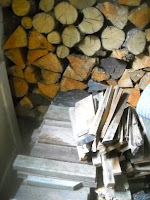Anyone
who believes that we live lives of Voluntary Simplicity because we have a
couple of hens in the backyard, some locally grown tomatoes on the shelf and
one car in the driveway has not seen my schedule book lately. I am beginning to
feel like an Honors Junior angling towards Stanford. They have colored coded
planners, fifteen things happening in a day, and no time for the common cold,
never mind a weekend off. Me, too. We are all
practicing Voluntary Complexity, not Voluntary Simplicity.
I
once lived a very simple life. My last year in college, I had a two room
apartment with the bathroom down the hall. I shared the second floor of an old
house with three dirty old men, literally. The front room held my bed, a
bookshelf, rocking chair, chest of drawers, and record collection. There was a
small open space where I could sit on the floor and spread out my notecards
before beginning to write a paper. The kitchen held my other bookshelf, which
functioned as the prep counter, a small table, tiny fridge, and my big desk
with manual typewriter. I went to the Laundromat and grocery store every
Saturday morning, baked my own bread, learned how to make soup, and decided
meat was, really, too expensive for what you got. I spent my evenings reading
eighteenth century fiction and New England history, my days working in the
archives, attending classes, and hanging out with friends at lunch. I did not
have a car, a cat, or a boyfriend. I agreed with May Sarton, who said that one
could live well alone at twenty and again at fifty, and with Adrienne Rich, who
talked about the need to choose how to live, alone or with a
partner. It was a good time in my life.
Life
now is far more complicated. As all teachers know—and the people who make
decisions at least pretend to deny—any time you add a life to your own, it adds
complication. Seeing 163 students every other day (and all of them on Friday)
requires more tracking and more effort than seeing 81 of them every day for one
semester, followed by 82 every day for the next. Just look at the pile of
summer reading projects on my counter, waiting for Monday morning. Over the fifteen years we have lived in this
little house, I have added many lives to my own, starting with a “housebound”
partner and two cats and moving outward from there. Every relationship adds
complexity. Every volunteer action, every group, every meeting I attend, every
student I stay in touch with years later, adds complexity. Sometimes, like at
the beginning of the school year when everything converges at once, it is not a
good thing. Sometimes I remember that little apartment fondly.
But
Voluntary Complexity has a positive side, beyond stress. Every connection we
make strengthens our lives as well. We are tangled in a web and it provides a
springboard and a safety net. Before school began, my friend Julia—the high
school art teacher-- and I organized an Art Retreat for our colleagues and
summer hiking partners. It was simple. Bring art supplies and picnic food,
gather at my house for carpooling, and head to Alsea Falls. We found a spot
with two tables, spread the excellent food on one, art supplies on the other,
listened to Julia explain a little bit about watercolors, and dispersed. Some people went for walks in the woods.
Some settled in with a plate of food and notebook at the table. Some headed for
the river to draw. I sat by the water, wrestling, as always, with perspective,
then stopped. Amy sat in front of me, her feet in the stream, staring into
space. I could hear seven year old Layne telling someone a story behind me, her
voice mingling with the river. Another friend settled in nearby. Other families
came and went. The breeze rustled in the dry August leaves. Back at the picnic
table, I knew, were other members of my web, talking, patting the dog, and
strengthening ties for the coming school year. As the day began to fade, we
came together once more, ate, and packed up to leave. The evening was pale pink
as we pulled out of the park. Doug firs sketched against the sky. The road a
dark tunnel through the trees until we broke into the valley and headed north,
towards home. Mary’s Peak, our home mountain, on the left, the Willamette River
beyond the fields on the right.
Drying Fruit for Winter Eating
One of the actions that lends complexity to my life in
September is the desire to be Fruit Independent all winter. Over the years,
we’ve learned that local, often scavenged, totally ripe fruit is infinitely
better than fruit picked green and shipped across the world. I have a small
food drier that I bought for thirty dollars at Bi-Mart and it works just fine.
No need for fancy equipment.
 |
| drying plums |
Keys to successful drying:
- Thin
slices—apples, pears, peaches
- Spread
it out a bit to expose more surface—plums, cherries, figs.
- Dry it
whole—blueberries and raisins.
- Have
patience—all of it. It takes longer than I once thought.
- Go for
really dry. If the fruit is dry, you can put it in a quart jar, seal it
with last year’s canning lid, and store it on the shelf with the canned
tomatoes and pickles. If you want
fleshy fruit, make a compote.











































